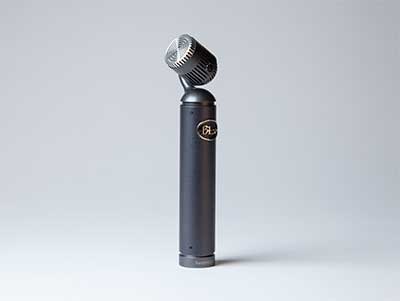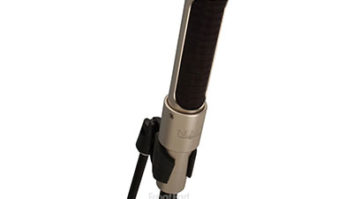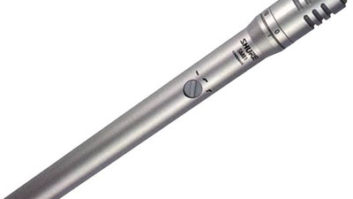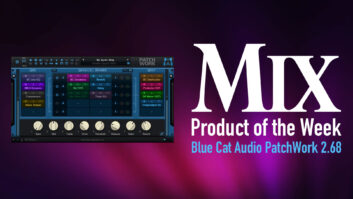
The Hummingbird is Blue Microphones’ new small-diaphragm condenser microphone that was designed to provide perfect positioning in hard-to-reach places. The solid, all metal mic is 6.5 inches long, 1 inch in diameter, and features Blue’s B1 cardioid capsule base on their Blue Bottle microphone capsules. The silver grille is an anodized aluminum design that resists corrosion and the occasional drumstick hit. The maximum sound pressure level is listed as 130 dB, which should handle even the hardest driving transients.
The Hummingbird does not have a built-in highpass filter or pad. It employs a Class-A, fully discrete circuit with no ICs in the signal path, adhering to the company’s penchant for offering state-of-the-art technology with the purest possible signal. The mic ships with a hard-shell, foam-lined case with a rubber mic clip and foam windscreen inside. Unlike most small-diaphragm condensers, the Hummingbird is designed to be just big enough to fit securely in a normal-size mic clip should the provided clip be lost or unavailable.
Into the Studio
The majority of testing was done with a pair of Hummingbirds sent through a stereo Great River MP-2NV preamp along with GR’s EQ-2NV, then an Ashly SC-55 compressor feeding an Apogee AD16 at 96k recorded into Magix Sequoia. Monitoring was done through a Mytek Stereo 192DSD D/A feeding Neumann speakers.
Miking a drum kit has always been a challenge due to the limited placement options around hardware. The Hummingbird’s swiveling head and swiveling body allows you to sneak it in under hi-hats and cymbals and reach snares and high toms at virtually any angle, and focus the head of the mic toward each drum’s sweet spot. I used the Hummingbirds on toms, congas, hand percussion and snare, but my favorite use was on toms, which sounded full and natural with plenty of extension into the lower frequencies. I tested the microphone’s transient response with a set of egg shakers and found the response to be good, tight and realistic. I also used them as room mics and found that the hot output is an added benefit for this sort of setup. While recording congas and other percussion instruments, the body and fullness of the instrument was always present without losing the delicateness of the hands on the drum skins. Capturing this detail and clarity while still sounding natural is a hard combination and tall order for any mic.
While recording a Gibson jumbo acoustic, I placed the Hummingbird next to an sE5 microphone and aligned them together about 9 inches out from the 12th fret facing the sound hole. The two mics sound very different. While the sE5 captured the sound with a nice sheen to the highs and an up-front type of presence, the Hummingbird sounded big in the bottom end. The highs and mids were natural. The sE5’s sound would be better suited in a dense mix to cut through, whereas the Hummingbird is the mic you want when the acoustic is the main instrument in a mix or solo.
Next, I listened to the mic spun around in different positions. I rotated the head toward the neck, toward the sound hole, up toward my chin, and down at the pick guard. In all the swiveling and twisting, there was just a slight change to the frequency response but not to the timbre.
While tracking a Taylor Baritone acoustic, the Hummingbird had much more body than the sE5, with slightly less highs and a little more of a natural response. The Hummingbird captured about 3 dB more between 90-160 Hz and a few dBs less in the 5-7kHz range. In comparison to an Audio-Technica 4050, not only did the Hummingbird exhibit a more rounded and natural tone with slightly more bottom end, but it was also faster on the transients. I was truly surprised at how this little mic had such a big sound.
The proximity effect of the Hummingbirds is strong. Within a few inches the bass response really increases, more than most small-diaphragm condenser mics I have used. Also, the side and rear rejection yields a different sound with a nice scooped mid and a high sheen that is more than usable in some situations. The “rejected” hi-hat sound while the Hummingbird was positioned for miking the snare drum was very nice sounding, nicer than I have ever heard a hi-hat end up sounding on a snare drum track.
Big Sound
The Hummingbird’s sound is as wonderful as its design and positioning abilities. I wish the stereo pair had come with a stereo mounting bar and was in a single case. I highly recommend the Hummingbirds, and the pair I used have found a new home here at my studio. n
Tim Dolbear is an Audio Engineer and Producer at Eclectica Studios in Austin, Texas.
Try This
When having trouble miking snare drum or tom because of the proximity of cymbals or other hardware, place the Hummingbird’s body vertical and parallel to the shell of the drum, then swivel the head at an extreme angle down toward the head. Use the available vertical space near the drums and the double-jointed design of the head to perfectly place the capsule every time.
PRODUCT SUMMARY
Company: Blue Microphones
Product name: Hummingbird
Website:www.bluemic.com
Price: $299
Pros: The swivel head makes placing the mic a breeze.
Cons: No built-in pad as mic has a very high output level.





